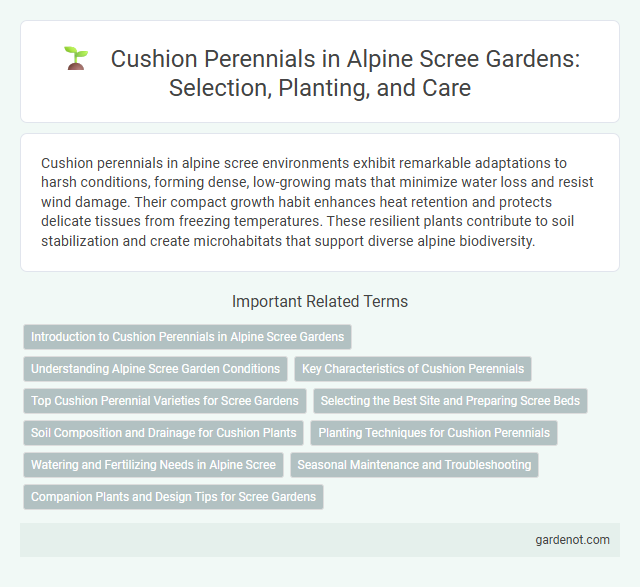Cushion perennials in alpine scree environments exhibit remarkable adaptations to harsh conditions, forming dense, low-growing mats that minimize water loss and resist wind damage. Their compact growth habit enhances heat retention and protects delicate tissues from freezing temperatures. These resilient plants contribute to soil stabilization and create microhabitats that support diverse alpine biodiversity.
Introduction to Cushion Perennials in Alpine Scree Gardens
Cushion perennials, such as Silene acaulis and Androsace spp., form dense, low-growing mats that thrive in the harsh conditions of alpine scree gardens. Their compact, cushion-like growth minimizes moisture loss and protects delicate roots from extreme temperature fluctuations and wind exposure. These resilient plants enhance soil stability and biodiversity in rocky, nutrient-poor environments commonly found at high altitudes.
Understanding Alpine Scree Garden Conditions
Cushion perennials thrive in alpine scree by adapting to the harsh, well-drained, and nutrient-poor soil conditions typical of these rocky slopes. Their dense, compact growth form reduces moisture loss and shields delicate roots from temperature extremes and wind erosion. Understanding these plant adaptations is essential for successful alpine scree garden cultivation and conservation.
Key Characteristics of Cushion Perennials
Cushion perennials display a dense, mat-forming growth habit that reduces exposure to harsh alpine winds and conserves moisture in scree environments. Their compact, low-profile structure minimizes heat loss and offers protection against temperature fluctuations common in high-altitude zones. These plants often feature small, leathery leaves with thick cuticles, enhancing their ability to withstand desiccation and nutrient-poor soils typical of alpine scree habitats.
Top Cushion Perennial Varieties for Scree Gardens
Top cushion perennial varieties for scree gardens include Androsace sempervivoides, Silene acaulis, and Arenaria montana, known for their dense, low-growing mats that stabilize soil and provide vibrant color. These species thrive in well-drained, rocky environments typical of alpine scree, exhibiting exceptional drought tolerance and compact growth habits. Their resilience to harsh conditions makes them ideal for enhancing biodiversity and aesthetics in challenging garden settings.
Selecting the Best Site and Preparing Scree Beds
Selecting the best site for cushion perennials requires well-drained, rocky alpine scree conditions with minimal soil moisture to mimic their natural habitat. Preparing scree beds involves incorporating coarse gravel and sand to ensure excellent drainage and reduce water retention, crucial for preventing root rot. Elevating beds and positioning them in full sun exposure also enhances growth by replicating high-altitude, sunlit scree environments.
Soil Composition and Drainage for Cushion Plants
Cushion perennial plants thrive in Alpine scree environments characterized by well-drained, coarse, and mineral-rich soil composed of gravel, sand, and decomposed rock fragments. These plants require soil with excellent drainage to prevent root rot and ensure oxygen availability, enabling survival in harsh, nutrient-poor conditions. The porous soil structure facilitates rapid water runoff while retaining sufficient moisture to support the specialized root systems of cushion plants.
Planting Techniques for Cushion Perennials
Planting cushion perennials in alpine scree requires well-drained, gritty soil to mimic their natural rocky habitat and prevent root rot. Position plants in sunny locations with protection from harsh winds, ensuring adequate air circulation to reduce moisture-related diseases. Using a raised bed or scree mound enhances drainage and replicates alpine conditions essential for the healthy growth of cushion-forming perennials.
Watering and Fertilizing Needs in Alpine Scree
Cushion perennials in alpine scree require minimal watering, thriving best with well-drained, rocky soils that prevent waterlogging while maintaining occasional moisture during prolonged dry spells. Fertilizing needs are low; a light application of a balanced, slow-release fertilizer in early spring supports growth without overwhelming the plant's natural adaptation to nutrient-poor conditions. Over-fertilization can lead to weak growth and reduced resilience in the harsh alpine environment.
Seasonal Maintenance and Troubleshooting
Cushion perennials in alpine scree require precise seasonal maintenance, including early spring pruning to remove dead growth and enhance air circulation. Monitoring for root rot during wet seasons and adjusting irrigation helps prevent fungal diseases common in dense cushion forms. Regularly inspecting for pest infestations like aphids and implementing targeted organic treatments ensures healthy plant development throughout the year.
Companion Plants and Design Tips for Scree Gardens
Cushion perennials such as Silene acaulis and Androsace are ideal companion plants for alpine scree gardens due to their low-growing, mound-forming habit that stabilizes soil and conserves moisture. Pair these with drought-tolerant sedums, saxifrages, and alpine gentians to create a visually dynamic and ecologically balanced scree garden. Incorporate well-draining substrates and position plants to mimic natural alpine slopes, enhancing both aesthetic appeal and plant health in harsh, rocky environments.
Cushion perennial Infographic

 gardenot.com
gardenot.com